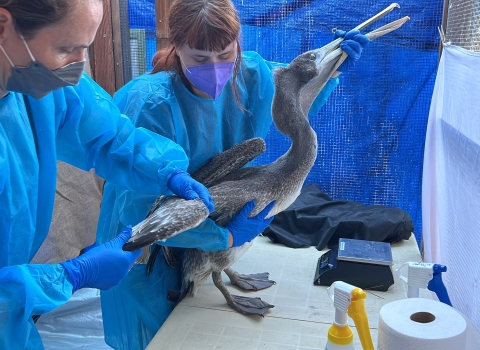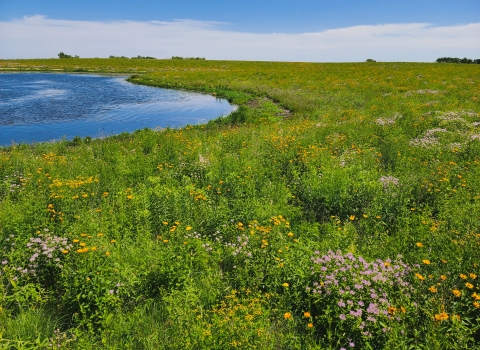DENVER –
Today, the U.S. Fish and Wildlife Service will release a draft recovery plan and ask for public comments on the conservation actions necessary to stop population declines and achieve recovery of the Gunnison sage-grouse. The bird was listed under the Endangered Species Act as threatened in November 2014. Now, the Service seeks public comments on a draft plan, especially from local communities and species experts.
“The proactive conservation actions undertaken by Gunnison County, Colorado Parks and Wildlife, and many local citizens have already benefited this bird,” said Noreen Walsh, U.S. Fish and Wildlife Service Regional Director. “Recovering this iconic species to the point that it does not need any federal protection is a shared goal. This draft recovery plan starts to outline how we can work together to get there, and we will need everyone’s input.”
Recovery is the process that stops the decline of an endangered or threatened species by removing or reducing threats, with the ultimate goal of ensuring the long-term survival of the species in the wild. Recovery plans describe the detailed, site-specific management actions necessary for each species, criteria for its delisting, and time and cost estimates for implementation of those actions. They are not regulatory documents and instead serve as guidance for federal, state, and private cooperators on how best to help imperiled plants and animals meet recovery goals.
The draft plan was developed with Colorado Parks and Wildlife and Utah Division of Wildlife Resources, and further refined through collaboration with local land management agencies, counties in the range of Gunnison sage-grouse, and local experts.
Like its cousin, the greater sage-grouse, the Gunnison sage-grouse makes its home exclusively in sagebrush sagebrush
The western United States’ sagebrush country encompasses over 175 million acres of public and private lands. The sagebrush landscape provides many benefits to our rural economies and communities, and it serves as crucial habitat for a diversity of wildlife, including the iconic greater sage-grouse and over 350 other species.
Learn more about sagebrush country. Sagebrush habitats serve as the lifeblood of western rural economies, supporting American agriculture, energy, and small business while providing clean air and water for people and over 350 species of wildlife.
Since the 1900s, the available habitat for the Gunnison sage-grouse has shrunk by approximately 90%, primarily due to the conversion of its sagebrush habitats for agricultural, residential, and commercial purposes. Once native to southwestern Colorado, northern New Mexico, southeastern Utah, and northeastern Arizona, today Gunnison sage-grouse are found in eight populations exclusively in southwestern Colorado and southeastern Utah.
The draft recovery plan outlines that the Gunnison sage-grouse needs at least five resilient populations that can withstand catastrophe and adapt to environmental change. These populations must be distributed across their range in order to maximize the species’ ecological and genetic diversity, therefore, the Gunnison Basin, San Miguel Basin, Piñon Mesa, Crawford, and Monticello populations each have specific targets in the plan. In addition, the plan identifies a need for improved habitat conditions in the Dove Creek and Cerro Summit-Cimarron-Sims Mesa populations.
Successful working rangelands play a critical role in supporting healthy wildlife populations, making ranchers and agricultural producers valued stewards of sagebrush and Gunnison-sage-grouse habitat. Approximately 43% of the lands where Gunnison sage-grouse currently reside are privately owned, and 42% are managed by the Bureau of Land Management. The remaining portions are managed by the U.S. Forest Service, the National Park Service, and the states of Colorado and Utah.
“Our ongoing collaboration with counties, states, stockgrowers, and other interested members of the communities supporting these birds have helped us to complete the draft plan. We will continue working with these partners to further improve the recovery plan and develop recovery implementation strategies for each population,” said Ann Timberman, Supervisor for the U.S. Fish and Wildlife Service’s office in Grand Junction, Colorado. “The recovery implementation strategies will be based on local knowledge and expertise, and driven by the conservation goals of the community, along with the draft recovery actions.”
Comments will be accepted on the draft recovery plan until December 31, 2019. To submit comments electronically, email them to GUSGrecoveryplan@fws.gov. Submit comments in-person or by mail to:
Colorado Ecological Services Field Office
U.S. Fish and Wildlife Service
445 West Gunnison Avenue, #240
Grand Junction, CO 81501-5711
The U.S. Fish and Wildlife Service works with others to conserve, protect, and enhance fish, wildlife, plants, and their habitats for the continuing benefit of the American people. For more information, connect connect with us through any of these social media channels: Facebook, Twitter, Flickr, YouTube, and Instagram.


